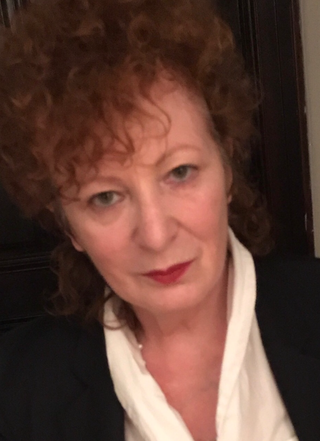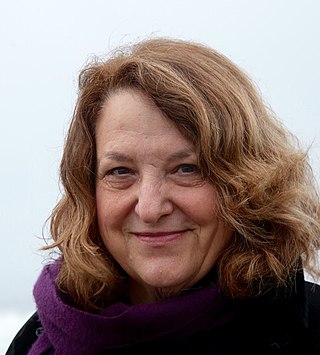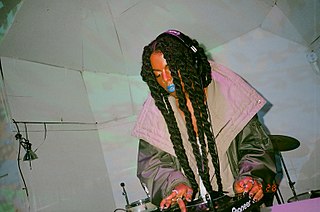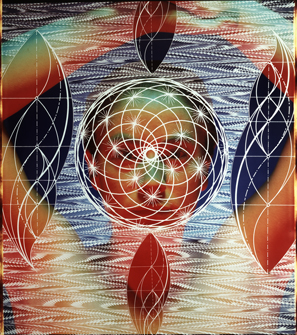Related Research Articles

Nancy Goldin is an American photographer and activist. Her work explores in snapshot-style the emotions of the individual, in intimate relationships, and the bohemian LGBT subcultural communities, especially dealing with the devastating HIV/AIDS crisis of the 1980s. Her most notable work is The Ballad of Sexual Dependency. In the slideshow and monograph (1986) Goldin portrayed her chosen "family", meanwhile documenting the post-punk and gay subcultures. She is a founding member of the advocacy group P.A.I.N. against the opioid epidemic. She lives and works in New York City.
Martha Rosler is an American artist. She is a conceptual artist who works in photography and photo text, video, installation, sculpture, site-specific and performance, as well as writing about art and culture. Rosler's work is centered on everyday life and the public sphere, often with an eye to women's experience. Recurrent concerns are the media and war, as well as architecture and the built environment, from housing and homelessness to places of passage and systems of transport.

A photogram is a photographic image made without a camera by placing objects directly onto the surface of a light-sensitive material such as photographic paper and then exposing it to light.

Miranda July is an American film director, screenwriter, actress and author. Her body of work includes film, fiction, monologue, digital presentations and live performance art.

Anohni Hegarty, styled as ANOHNI, is a British-born American singer, songwriter, and visual artist. She has presented solo work and as the lead singer of the band Anohni and the Johnsons, formerly known as Antony and the Johnsons.

Gwyneth Herbert is a British singer-songwriter, composer, multi-instrumentalist and record producer. Initially known for her interpretation of jazz and swing standards, she is now established as a writer of original compositions, including musical theatre. She has been described as "an exquisite wordsmith" with "a voice that can effortlessly render any emotion with commanding ease" and her songs as being "impressively crafted and engrossing vignette[s] of life's more difficult moments".

Lynn Hershman Leeson is an American multimedia artist and filmmaker. Her work with technology and in media-based practices is credited with helping to legitimize digital art forms. Her interests include feminism, race, surveillance, and artificial intelligence and identity theft through algorithms and data tracking.

Iris Haeussler is a conceptual and installation art artist of German origin. She lives in Toronto, Canada. Many of Iris Haeussler's works are detailed, hyperrealistic installations that visitors can decode as narrative stories. Recurring topics in her work include historic, cultural, social and geographic origins; family ties, relationships, memory, history, trauma and obsession.
Julie Heffernan is an American painter whose work has been described by the writer Rebecca Solnit as "a new kind of history painting" and by The New Yorker as "ironic rococo surrealism with a social-satirical twist". Heffernan has been a Professor of Fine Arts at Montclair State University in Upper Montclair, New Jersey since 1997. She lives in New York, New York.
Shary Boyle is a contemporary Canadian visual artist working in the mediums of sculpture, drawing, painting and performance art. She lives and works in Toronto.
Mariah Robertson is an American artist. She lives in New York City.
Lorna Mills is a Canadian net.art and new media artist who is known for her digital animations, videos, and GIFs. Mills has done work in other mediums such as installations. Her work explores how "the notion of public decency is anachronistic" Her use of GIFs are gathered through the dark net which includes 4chan, pornfails, and Russian domains. She currently lives and works in Toronto, Canada.

Juliana Huxtable is an American artist, writer, performer, DJ, and co-founder of the New York–based nightlife project Shock Value. Huxtable has exhibited and performed at a number of venues including Reena Spaulings Fine Art, Project Native Informant, Artists Space, the New Museum, the Museum of Modern Art, Portland Institute for Contemporary Art, and Institute of Contemporary Arts. Huxtable's multidisciplinary art practice explores a number of projects, such as the internet, the body, history, and text, often through a process she calls "conditioning." Huxtable is a published author of two books and a member of the New York City–based collective House of Ladosha. She is on the roster of the talent agency Discwoman, a New York based collective and talent agency that books DJs for parties and events around the world. She previously lived and worked in New York City, and has been based in Berlin since 2020.
Jonny Star is a German artist. Until 2011 she worked as an artist under her given name Gabriele-Maria Scheda. She lives and works in Berlin and in New York City, United States

Nadia Kaabi-Linke is a Tunis-born, Berlin-based visual artist best known for her conceptual art and 2011 sculpture Flying Carpets. Her work has explored themes of geopolitics, immigration, and transnational identities. Raised between Tunis, Kyiv, Dubai and Paris, she studied at the Tunis Institute of Fine Arts and received a Ph.D. in philosophy of art from the Sorbonne. Kaabi-Linke won the 2011 Abraaj Group Art Prize, which commissioned Flying Carpets, a hanging cage-like sculpture that casts geometric shadows onto the floor akin to the carpets of Venetian street vendors. The piece was acquired by the New York Guggenheim in 2016 as part of their Guggenheim UBS MAP Global Art Initiative. Kaabi-Linke also won the Discoveries Prize for emerging art at the 2014 Art Basel Hong Kong. Her works have been collected by the Museum of Modern Art, Dallas Museum of Art, Burger Collection, and Samdani Art Foundation, and exhibited in multiple solo and group shows.
MMX Open Art Venue was an art gallery in Berlin, founded in 2010 as a one-year art experiment and reincarnated as re:MMX in 2012. The MMX project, which included the works of more than 200 international artists, was noted as the revival of the concept of artist collectives in Berlin.

Ellen Carey is an American artist known for conceptual photography exploring non-traditional approaches involving process, exposure, and paper. Her work has ranged from painted and multiple-exposure, Polaroid 20 x 24, Neo-Geo self-portraits beginning in the late 1970s to cameraless, abstract photograms and minimal Polaroid images from the 1990s onward, which critics often compare to color-field painting. Carey's sixty one-person exhibitions have been presented at museums, such as the Amon Carter Museum of American Art, International Center of Photography (ICP) and Wadsworth Atheneum Museum of Art, alternative spaces such as Hallwalls and Real Art Ways, and many commercial galleries. Her work is in numerous museum collections, including those of the Metropolitan Museum of Art, Whitney Museum of American Art, Los Angeles County Museum of Art, Centre Pompidou, and Smithsonian American Art Museum. In 2019, she was named one of the Royal Photographic Society (London) "Hundred Heroines", recognizing leading women photographers worldwide. Los Angeles Times critic Leah Ollman describes her photography as "inventive, physically involving, process-oriented work" and her recent photograms as "performative sculptures enacted in the gestational space of the darkroom" whose pure hues, shadows and color shifts deliver "optical buzz and conceptual bang". New York Times critic William Zimmer wrote that her work "aspires to be nothing less than a reinvention, or at least a reconsideration, of the roots or the essence of photography." In addition to her art career, Carey has also been a longtime educator at the Hartford Art School and a writer and researcher on the history of photography.
Jeanine Oleson is an American interdisciplinary artist working with images, materials and language that she forms into complex and humorous objects, performance, film, video, sound, and installation. Oleson's work explores themes including audience, language, land/site, music, and late Capitalist alienation

Lena Braun is a Berlin-based artist, curator and author. She works as a cross-genre artist in the fields of performance and visual arts, often addressing non-normative femininity and gender expression. The art spaces that she has curated since 1988 have earned her the reputation of being a "Grand Dame" of Berlin's art scene.
Nadja Verena Marcin (1982-present) is a Berlin and New York-based visual artist, performance artist, and filmmaker. Her work examines themes of gender, history, morality, psychology, and human behavior, through an intersectional feminist lens. Marcin's practice integrates elements of theater and cinema, frequently exploring the representation of women in media.
References
- 1 2 3 4 5 6 7 Liz Pyburn-Wilk (October 26, 2011). "Dangerous Everyday: On Rebecca Loyche". Berlin Art Link. Archived from the original on March 3, 2016. Retrieved April 24, 2017.
- ↑ Caroline Williamson (March 20, 2012). "Still Life by Rebecca Loyche". Design Milk. Archived from the original on July 3, 2017. Retrieved April 24, 2017.
- 1 2 3 "Your Skin Makes Me Cry". Kuandu Museum of Fine Arts. 2014. Retrieved April 24, 2017.
- 1 2 "Studio Art: MFA Studio Berlin". College of Arts & Sciences. Retrieved April 24, 2017.
- ↑ "In Our Masthead: Rebecca Loyche". Art Fag City. November 19, 2007. Archived from the original on September 28, 2020. Retrieved April 24, 2017.
- 1 2 3 Aleesha Callahan (February 6, 2013). "Spotlight on Rebecca Loyche". Artconnect. Archived from the original on April 12, 2016. Retrieved April 24, 2017.
- ↑ Michèle C. Cone (December 28, 2007). "War and Sex". Artnet. Archived from the original on April 15, 2017. Retrieved April 24, 2017.
- ↑ Mara Wallat. "Rebecca Loyche [Videonale 12]". Videonale Online Archiv. Retrieved April 24, 2017.
- 1 2 3 4 "Rebecca Loyche: Selected Art Work 2008-2011". Scribd. Archived from the original on October 16, 2023. Retrieved April 24, 2017.
- ↑ "Variety is the Spice of Life". Art Parasites. April 16, 2012. Retrieved April 24, 2017.
- ↑ "Meet the Neighbours: Torstraße 111". The Circus. April 24, 2012. Retrieved April 24, 2017.
- ↑ "Demolition: Art & Choreography" (PDF). Urban Lab. March 5, 2013. Retrieved April 24, 2017.
- ↑ Claire Voon (July 14, 2014). "Japanese Artist In Trouble for Making Her Genitals Available to Others". Hyperallergic. Archived from the original on December 4, 2016. Retrieved April 24, 2017.
- ↑ M. H. Rowe (July 16, 2016). "The March of the Art Shanties". Public Art Review. Archived from the original on March 5, 2023. Retrieved April 24, 2017.
- ↑ Amy Carlson Gustafson (February 2, 2016). "Art on ice: Shanty Projects back at White Bear Lake". Twin Cities. Archived from the original on April 7, 2016. Retrieved April 24, 2017.